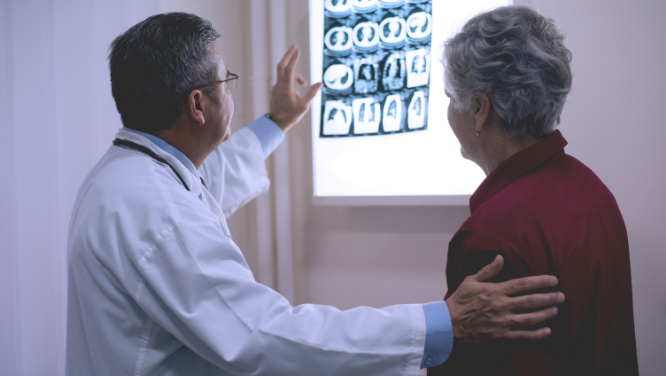Obesity Surgery Department
Obesity Surgery Department
What is Obesity Surgery?
What is obesity?
Obesity is a medical condition caused by abnormal or excessive fat accumulation that presents a risk to health. People are considered obese when their body mass index (BMI), which is a a measurement obtained by dividing a person's weight by the square of the person's height, is 25 kg/m2 to 30 kg/m2 or above. Waist circumference measurement is considered another indicator of obesity. Measuring waist circumference is a highly practical method of diagnosing obesity. A waist circumference measurement over 102 cm and 88 cm for men and women, respectively, is an indication of obesity.
What is the classification of obesity based on BMI?
According to the obesity classification defined by the World Health Organization based on Body Mass Index (BMI), people who has
- a BMI equal to or less than 18.5 are underweight
- a BMI greater than or equal to 18.5 to 24.9 are normal weight
- a BMI greater than or equal to 25.0 to 29.9 are overweight
- a BMI greater than or equal to 30.0 - 39.9 are obese
- a BMI greater than 40.0 are morbid (severely) obese
What is prevalence of obesity?
Obesity is considered as the most significant cause of morbidity and mortality (death) of the present-day both in Turkey and the world. For the last 40 years, obesity has increased in all around the world. Globally, the obesity prevalence by age in adults reached up to 14,8% and 10,8% for women and men, respectively in 2014 while it was 6,4% and 3,2%, respectively in 1975. Obesity prevalence is increasing in Turkey, as well. In our country, the obesity prevalence increased from 22,3% (32,9% for women and 13,2 for men) in 1998 to 31,2% (44,2% for women and 27,3 for men) in 2010. There is a remarkable increase of obesity prevalence in children and adolescents.
What are the causes of obesity?
Obesity is prevalent among those who frequently follow a high-calorie diet with inadequate physical activity or exercise as a life style. The other obesity-triggering causes include genetic predisposition, hormonal disorders, psychological problems and the antipsychotic drugs used. Although the popular wisdom is that the obesity is associated with low metabolic rate, this is, in fact, a rare cause of it.
Mostly, those who suffer from obesity, or in other words morbid obesity, burns more energy than those who are normal weight to meet the needs of the body. Therefore, those who suffer from obesity, has increased rate of basal metabolism. The advanced technology restricts the ability of obese people’s use of their body. This greatly aggravates their obesity.
It should be remembered that the greatest cause of the obesity is excessive intake of calorie and a sedentary lifestyle.
What are the health problems caused by obesity?
- Cardiovascular disorders: Coronary heart disease, cardiac insufficiency, occlusive vascular diseases, varices in legs
- Type 2 diabetes
- Certain types of cancer (uterus, breast, prostate and colon)
- Hypertension
- Dyslipidaemia (increased levels of cholesterol and triglycerides in blood)
- Stroke (seizure)
- Digestive system problems: Fatty liver, gallstones , gastroesophageal reflux
- Respiratory system disorders: sleep apnea, hyperventilation syndrome, pulmonary embolism
- Muscoskeletal system problems: osteoarthritis (damaged articular cartilage), herniated disk
- Uro-genital problems: menstrual irregularity or amenorrhea, polycystic ovary syndrome, infertility, urinary incontinence
- Psycho-social problems: incapacity to work, being subject to social discrimination, depression
What are the methods to treat obesity?
A successful treatment of obesity is possible through setting realistic goals and changing your lifestyle. The main goal is to be more active while consuming less calories and increasing the calories burnt. For this, first the daily intake of calorie and amount of physical activity should be increased.
The effective and successful treatment of obesity, just like any other medical condition, is possible through harmonized and patient efforts of the team in which the patient’s himself or herself is included. This team involves physicians, psychologists and psychiatrists, dieticians and any other specialists needed.
The team who are involved in the treatment of obesity must be formed by the specialists of the following disciplines:
- Dietary and Nutrition Therapy
- Exercise Therapy
- Behavioural Therapy
- Pharmacotherapy
- Obesity Surgery
Which methods are used in obesity surgery?
One of the major health problems of the present day is Metabolic Syndrome, induced by obesity and type 2 diabetes. All studies in fighting against the Metabolic Syndrome and the analyses in connection with these studies show that the conventional methods of treatment are unfortunately not adequately successful in treating the disease. Considering all methods of treatment, the scientific accumulation of knowledge demonstrates that the most effective results in the treatment of obesity and type 2 diabetes are obtained through the surgical intervention. A part of these methods shows that they produce effective and long-lasting results in the treatment of not only the obesity but also the type 2 diabetes and the co-morbid illnesses. Particularly in the last 30 years, there have been many methods developed for the surgical treatment of the obesity and type 2 diabetes. Over time, some of these methods were abandoned while others are still successfully used today thanks to their effective long-term results.
Just like in any other method of treatment, surgical procedures have both advantages and disadvantages. Besides, surgical methods have strengths and weaknesses over each other. The most frequently used ones of them are as follows:
1) Sleeve Gastrectomy
Sleeve gastrectomy is the removal of large part of the stomach which serves as storage of the stomach. This way, the stomach which has a volume of 1.5-2 litres is transformed into a thin tube with a volume of 50-150 ml. In this technique, the amount of the food which can be taken at a time is reduced but the natural course of the digestive system is intervened. This operation is performed through laparoscopic method, namely using 4 to 5 small incisions near the belly button. The operation takes about 45 to 75 minutes. The length of stay in hospital is usually 2 to 3 days.
The main advantages of the sleeve gastrectomy are that it does not change the natural course of the digestion system, thus leading less deficiency of vitamin and mineral, the incidence of Dumping syndrome is lower, it is less probable to lead the reflux complaint, and that not foreign object is inserted in the body. However, it has some disadvantages, which mainly include reflux, existence of a long stapler line (bleeding and leakage through stapler line) and irreversibility. In other words, the side effects of sleeve gastrectomy are less compared to the gastric bypass and the larger operations.

How does sleeve gastrectomy work?
During the procedure, almost 80 % of the stomach is removed leaving a narrow gastric tube. This way, the amount of the food which can be taken is significantly reduced and one feels full quickly. This is the restrictive effect of the operation. However, the part removed during the sleeve gastrectomy is the part producing the Ghrelin hormone which triggers the hunger. The removal of this part reduces the amount of the hormone triggering the hunger in blood, usually diminishing the appetite. This also accounts for the metabolic and hormonal effects of this operation. As the natural course of the digestive system is not intervened, the digestion and absorption normally continues after the sleeve gastrectomy. Thus, there is lower risk of vitamin and mineral deficiency.
How much weight is lost after sleeve gastrectomy?
Obesity is a complicated problem, which is not only an imbalance of caloric intake and calories burnt. Obesity has many underlying hormonal mechanisms. When sleeve gastrectomy is supported with a healthy diet and exercise, it enables the loss of 60 to 80% of the overweight over one or two years following the operation. However, there is a risk of inability to lose adequate weight or even re-gaining weight when the rules are not obeyed and the old bad habits are back.
2) Laparoscopic gastric bypass surgery
Gastric bypass surgeries has been the most frequently performed type of surgery in USA where the greatest number of obesity surgery is performed in the world, for the last 30 years. The bypass technique used has changed over years. Today, the regulation of the digestion system through gastric bypass surgery is extremely effective and safe procedure provided that it is performed by experienced bariatric surgeons. For the suitable candidates, the gains from this surgery are many times more than its risks.
Gastric bypass is a combined procedure involving both volume restrictive and absorption reducing effects. The first step of the operation is separating a small part with a volume of 30 to 35 ml of the stomach on the upper section of it through a stapler creating a smaller and newer pouch of stomach. This way, the feel of being full up is ensured with a small amount of food. The second step of the operation is bypassing the small intestines. Namely, the remaining part of the stomach and small intestines are bypassed. This part continues its function of conveying the enzymes such as gastric acid, bile and pancreatic fluids, which play a role in digestion. The newer part of the stomach created is anastomosed to a small intestine segment which is located about 150 to 200 cm below, which means that a part of the food taken is eliminated without being absorbed.
What provides the main metabolic strength of the surgery is another mechanism. Certain hormones which are excreted by the last part of the small intestine and called incretin, has an action parallel and provides support to insulin which adjusts the blood glucose. At the same time, the hormones which give the feeling of fullness and diminish the appetite are excreted by this part.

Just like the other types of obesity surgery, we perform the gastric bypass surgery by laparoscopic method, namely by entering through an incision of only 4 mm without opening up your stomach. The duration of the operation is 3 to 4 hours. Of course, this may vary depending on the anatomy and surgical history of the patient. The average length of stay in hospital is 3 to 4 days.
Gastric bypass surgery is a highly powerful weapon in your fight against obesity. Most of the patients loses 65 to 90 % of their overweight within the first year of the operation. Gastric bypass operation also provides perfect results in the treatment of the co-morbid diseases associated with obesity, which mainly include type 2 diabetes, hypertension, sleep apnoea, high cholesterol and acid reflux. Slow-down of weight loss or even re-gain of the lost weight is possible in this surgery, as in the other operations, when the patients do not follow the healthy diet and our advices about regular exercise.
When the absorption of calories is reduced, the absorption of some other important nutrients is also reduced. The bypassed part of the small intestine accounts for the absorption of the calcium, folic acid, iron and B vitamins. To prevent serious health problems, you should avoid vitamin and mineral deficiencies and take personalised vitamin-mineral supplements after bypass surgery.
Robot-Assisted Obesity Surgery:
Surgical treatment is the most effective treatment method with proven effectiveness in the treatment of severe obesity patients and treatment-resistant type 2 diabetes patients. All obesity and metabolic surgery operations can be performed with minimally invasive methods (laparoscopic and robotic).
ROBOT-ASSISTED SURGERY, which is not available in every center and can only be used by a small number of surgeons, is superior to laparoscopic surgery in many ways. Robotic surgery is a surgical technique that can use techniques and equipment that minimally damage tissues in surgical interventions. Robotic surgery has all the benefits of laparoscopic surgery, such as less pain, short hospital stay, and good cosmetic results. The cosmetic results of robotic surgery are excellent.
Robotic surgery can also be considered as an advanced laparoscopic surgery. The basic operating principles are similar to laparoscopic surgery. First, 4-5 8 mm holes are opened in the abdominal wall and the abdomen is inflated with carbon dioxide gas to create an area for the study. Then, special robotic arms, which are specially designed for robotic surgery and prevent damage to the abdominal wall, are attached to these holes. Surgery is performed with the help of these arms with high mobility. A high-resolution camera is attached to one of the holes and this camera transmits the surgical images both to the console where the surgeon performs the operation and to a large monitor located at the head of the operating bed. After this stage, the 1st surgeon leaves his place to an experienced assistant, goes to a special console designed for him, and performs the surgery with the commands he gives from there. The surgical console is the unit where all the settings related to the robot are made and the surgeon performs the surgery using special hand tools. The movements of the surgeon are reflected in the arms of the robot, and the surgery is performed thanks to the fine movements of the robot arms and the ability to work easily in narrow spaces.
The three-dimensional and high-quality image of the robotic camera gives the surgeon the feeling of operating with his naked eyes. In fact, thanks to the magnified image, it allows to see more clearly even the structures that the human eye can hardly see. The wrist part of the robotic arms has the ability to work similarly to the human wrist. In fact, with its high degree of mobility, it has more mobility than the human wrist. Even in tight spaces, many difficult surgical procedures can be easily performed with the robot thanks to this mobility. Since these instruments are also powerful instruments, they provide ease of operation, especially in overweight (obese) patients. With all the above-mentioned features, robotic surgery enables the surgeon to perform surgical procedures with high accuracy and precision.
To summarize, robotic surgery, which offers all the possibilities of modern technology, can be safely used in the surgical treatment of morbid obesity and type 2 diabetes.
General Surgery
Assoc. Prof. Abdulcabbar Kartal
Videos
All videosObezite Cerrahisi Hakkında Merak Edilenler - Canlı Yayın
Obezite Cerrahisi Hakkında Merak Edilenler - Canlı Yayın

We listen to your opinions and suggestions to further enhance our service quality.

You can fill out the form to get a second doctor's opinion on the results of your tests, the diagnosis of your illness, and the treatment options we offer you.

You can receive the healthcare services you need at your home. Please fill out the form for home healthcare services.
Featured Articles
- 6 Nutrition Tips for Those Who Fast
- What is Disease X (Virus X)?
- How Does Cancer Form?
- What is an Ovarian Cyst?
- What is Cervical Cancer?
- What Are the Symptoms and Treatment Methods of Testicular Cancer?
- Symptoms, Diagnosis, and Treatment Process of Bladder Cancer
- Liver Cancer
- What is Stomach Cancer? What are Its Symptoms and Treatment?
- Thyroid: What is it, Symptoms, Diagnosis, and Treatment







